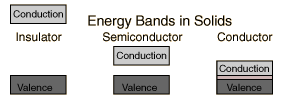I am trying to get a clear picture of the valence band, conduction band, and the band gap. Now I've been researching it for a little while now and understand most of what's going on. I'm still a little confused about some specifics though, so if you could please address the following, that would be great!
My favorite description thus far has been
"The most important aspect of semiconductor bandstructure may be summarised as follows; at absolute zero the highest completely filled band (the valence band) is separated from the lowest empty band (the conduction band) by an energy gap or band gap Eg of forbidden states. Therefore the material does not conduct electricity at T = 0."
So from this description I have a pretty clear idea of what the valence band is (with the supplement of a few diagrams). Also, I know the conduction band is above the valence band in terms of energy, and is where electrons are free to roam the material as conduction electrons. My problem is where this "conduction band" is physically. It seems like there should be some allowed state, where if you just excite one electron you pass into that new state. From the above description, it seems to say some of these states are "forbidden", and that is my main question resides. Where is this conduction band, what determines its range (an example would be fantastic), and how do we determine what is necessarily a "forbidden" state?
Thanks =)


